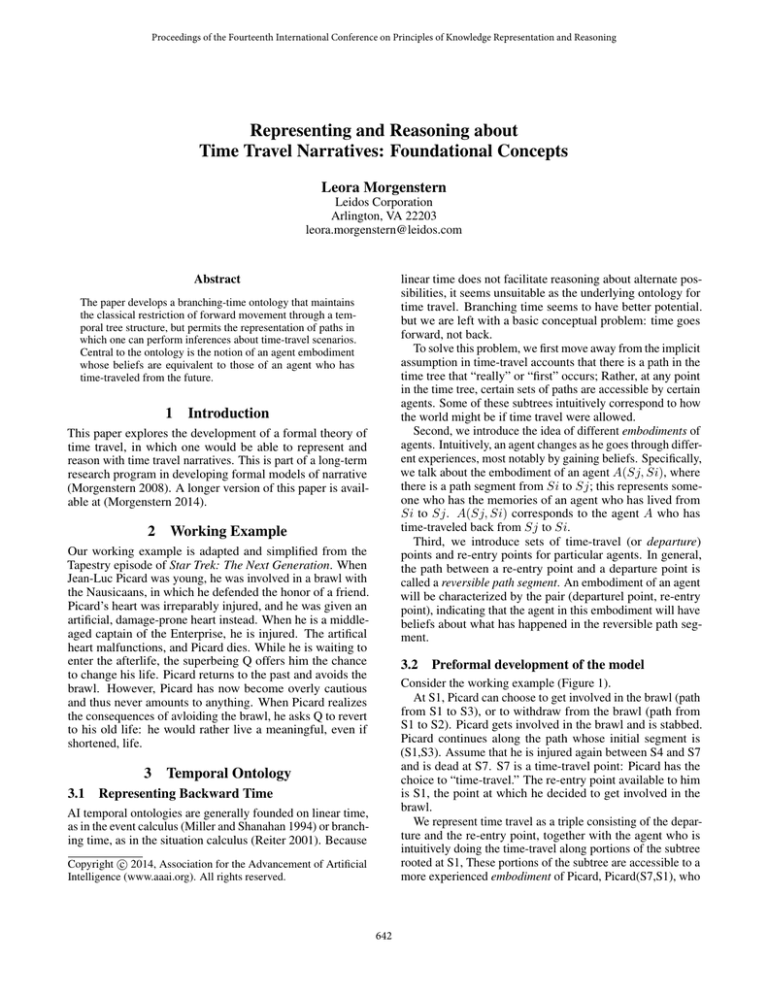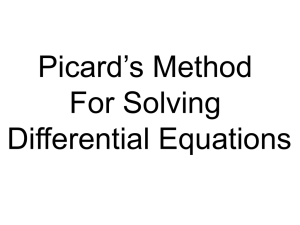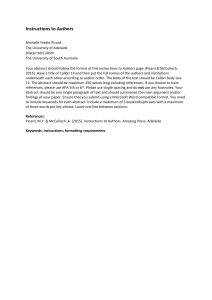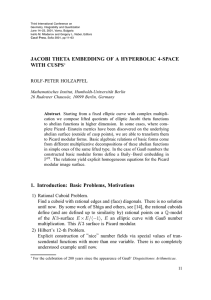Representing and Reasoning about Time Travel Narratives: Foundational Concepts Leora Morgenstern
advertisement

Proceedings of the Fourteenth International Conference on Principles of Knowledge Representation and Reasoning
Representing and Reasoning about
Time Travel Narratives: Foundational Concepts
Leora Morgenstern
Leidos Corporation
Arlington, VA 22203
leora.morgenstern@leidos.com
Abstract
linear time does not facilitate reasoning about alternate possibilities, it seems unsuitable as the underlying ontology for
time travel. Branching time seems to have better potential.
but we are left with a basic conceptual problem: time goes
forward, not back.
To solve this problem, we first move away from the implicit
assumption in time-travel accounts that there is a path in the
time tree that “really” or “first” occurs; Rather, at any point
in the time tree, certain sets of paths are accessible by certain
agents. Some of these subtrees intuitively correspond to how
the world might be if time travel were allowed.
Second, we introduce the idea of different embodiments of
agents. Intuitively, an agent changes as he goes through different experiences, most notably by gaining beliefs. Specifically,
we talk about the embodiment of an agent A(Sj, Si), where
there is a path segment from Si to Sj; this represents someone who has the memories of an agent who has lived from
Si to Sj. A(Sj, Si) corresponds to the agent A who has
time-traveled back from Sj to Si.
Third, we introduce sets of time-travel (or departure)
points and re-entry points for particular agents. In general,
the path between a re-entry point and a departure point is
called a reversible path segment. An embodiment of an agent
will be characterized by the pair (departurel point, re-entry
point), indicating that the agent in this embodiment will have
beliefs about what has happened in the reversible path segment.
The paper develops a branching-time ontology that maintains
the classical restriction of forward movement through a temporal tree structure, but permits the representation of paths in
which one can perform inferences about time-travel scenarios.
Central to the ontology is the notion of an agent embodiment
whose beliefs are equivalent to those of an agent who has
time-traveled from the future.
1
Introduction
This paper explores the development of a formal theory of
time travel, in which one would be able to represent and
reason with time travel narratives. This is part of a long-term
research program in developing formal models of narrative
(Morgenstern 2008). A longer version of this paper is available at (Morgenstern 2014).
2
Working Example
Our working example is adapted and simplified from the
Tapestry episode of Star Trek: The Next Generation. When
Jean-Luc Picard was young, he was involved in a brawl with
the Nausicaans, in which he defended the honor of a friend.
Picard’s heart was irreparably injured, and he was given an
artificial, damage-prone heart instead. When he is a middleaged captain of the Enterprise, he is injured. The artifical
heart malfunctions, and Picard dies. While he is waiting to
enter the afterlife, the superbeing Q offers him the chance
to change his life. Picard returns to the past and avoids the
brawl. However, Picard has now become overly cautious
and thus never amounts to anything. When Picard realizes
the consequences of avloiding the brawl, he asks Q to revert
to his old life: he would rather live a meaningful, even if
shortened, life.
3
3.1
3.2
Preformal development of the model
Consider the working example (Figure 1).
At S1, Picard can choose to get involved in the brawl (path
from S1 to S3), or to withdraw from the brawl (path from
S1 to S2). Picard gets involved in the brawl and is stabbed.
Picard continues along the path whose initial segment is
(S1,S3). Assume that he is injured again between S4 and S7
and is dead at S7. S7 is a time-travel point: Picard has the
choice to “time-travel.” The re-entry point available to him
is S1, the point at which he decided to get involved in the
brawl.
We represent time travel as a triple consisting of the departure and the re-entry point, together with the agent who is
intuitively doing the time-travel along portions of the subtree
rooted at S1, These portions of the subtree are accessible to a
more experienced embodiment of Picard, Picard(S7,S1), who
Temporal Ontology
Representing Backward Time
AI temporal ontologies are generally founded on linear time,
as in the event calculus (Miller and Shanahan 1994) or branching time, as in the situation calculus (Reiter 2001). Because
c 2014, Association for the Advancement of Artificial
Copyright Intelligence (www.aaai.org). All rights reserved.
642
S8
S2
S7
S4
S1
P brawls/gets stabbed
S3
S14
P(S7,S1) leads unfulfilled life
S12
P(S7,S1,S13,S1)
Brawls;
Gets stabbed
S15
S10
Time-travel point:
Re-entry at S1
S5
S6
S11
(AE) ag may be primary, intuitively an agent who has not
(yet) time traveled, or secondary, intuitively one who has
time traveled.
A primary AE is represented as a, possibly subscripted; a secondary AE is represented as a 2n + 1-tuple
(a, dp1 , rp1 , . . . , dpn , rpn ) where a is a primary agent, each
dpi ∈ DP , each rpi ∈ RP , and (for backward time travel),
for each dpi , rpi , it is the case that dpi > rpi .
For n
≥
1, we can represent the AE as
(a, dp1 , rp1 , . . . , dpn−1 , rpn−1 )(dpn , rpn ).The
AE
(a, dp1 , rp1 , . . . , dpn−1 , rpn−1 ) is the generating AE,
while (a, dp1 , rp1 , . . . , dpn , rpn ) is the generated AE.
Primary agents can only be generating AEs; secondary
agents can be both generating and generated AEs.
Notation 4.1.2: â or a’ is used to range over the primary AE
a as well as secondary AEs who are recursively generated
by a. This notation is useful when we wish to speak about
various embodiments of a specific primary agent. (See the
Proof in Example 4.5.2.)
τ : τ ⊆ AG × DP × RP . That is, τ is the set of all triples
of the form (ag, dpi , rpi ) which give all the possible ways
agent embodiments can travel through the time-travel tree
structure. If (ag, dpi , rpi ) is an element of τ , we say that rpi
is the re-entry point associated with dpi , from ag’s point of
view. Note that there may be several re-entry points for a
particular departure point of an AE, and several departure
points for a re-entry point of a particular AE. Fig. 1 gives an
example of the latter scenario.
T: A set of subtrees of S, one for each AE. Assume e is
an AE (a, dp1 , rp1 , . . . , dpn , rpn ).Te denotes the subtree
rooted at rpn , the time at which e is first active.
Isomorphisms between subtrees: For each primary AE
a, Ta is the subtree of S during which a is active. Let
P as denote the subtree of Ta that is rooted at s. If e =
(a, dp1 , rp1 , . . . , dpn , rpn ), then there is an isomorphism between P as and Te . Let σ(s) denote the image in Te under
this isomorphism. Note that if P as and Te share the root
rpi , then σ(rpi ) = rpi . The existence of this isomorphism is
what makes it possible to represent the secondary AE being
faced with the same choices that the primary AE faced, and
(possibly) making different choices.
S9
P gets humdrum job
S13
Time-travel point:
Re-entry at S1
P(S7,S1,S13,S1) artificial heart
malfunctions
Figure 1: Star Trek TNG Tapestry Example.
chooses now to follow a different path. He can no longer
follow the path from S1 to S2 but he follows a similar path
in which he avoids the brawl (S1,S6).
Nested Time Travel and Embodiments: The time-travel
process can be repeated along the path segment of an embodied agent, leading to nested embodiments. E.g., the embodiment of Picard who is aware that brawling will shorten his
life realizes, when middle-aged, that he never amounted to
anything because he avoided the brawl. This embodiment
then has a possibility of time travel at S13 and an associated
re-entry point at S1. (See Fig. 1.)
Embodiment along a path stays the same or grows deeper,
but does not grow shallower. An agent is marked by the path
segments that he believes he has lived.
4
4.1
Formal Model
The Time-Travel Tree Structure
Definition 4.1.1 A time-travel tree structure TTT is a tuple
(S,Act,DP,RP,AG, τ , T), whose elements are described below: 1
S: S is an infinite set of situations, arranged into a partial
order under the precedes relation <. The function time
maps a situation onto its date-clock-time. If s1 < s2, then
time(s1) < time(s2). There is a path between any two
ordered situations. start and end are functions giving the
start and end situations of any finite path segment.
Act: A set of actions of the form do(ag, ac) where ag is
an agent (see below) and ac is an actional, intuitively, an
unanchored action type. Occurs(do(ag,act),s1,s2) means that
the action of ag performing ac occurs between situations s1
and s2.
DP: A set DP ⊂ S of departure points, intuitively corresponding to those situations in which an agent can decide to travel
to the past, or is involuntarily dispatched to a point inthe past.
(Or to the future, in models permitting such time travel.)
RP: A set RP ⊂ S of re-entry points, intuitively corresponding to those situations to which an agent time travels.
AG: A set of agent embodiments ag. An agent embodiment
4.2
Belief
We use a standard possible worlds semantics of belief as in
(Fagin et al. 1995) Thus we have the standard definition of
belief in terms of belief-accessible worlds:
Definition 4.2.1:
Holds(s,Bel(ag,p)) ⇔
∀ s B(ag,s,s’) ⇒ Holds(s’,p)
We need to be able to say that the more an AE has time
traveled, the more an agent believes. Equivalently, fewer
possible worlds are belief-accessible to him. Recall that a
generating AE and the corresponding generated AE inhabit
separate worlds. This is built into the structure of the TTT:
there are separate, isomorphic structures for generated AEs.
We can use the mapping σ between the situations in the
isomorphic structures to give us precisely what we need:
Axiom4.2.2:
B(a(dp1 , rp1 , . . . , dpn , rpn ), σ(s), σ(s0 ))
⇒B(a(dp1 , rp1 , . . . , dpn−1 , rpn−1 ), s, s0 )
1
What follows is based on the theory of knowledge and action in
(Davis and Morgenstern 2005); however, belief is used here instead
of knowledge.
643
4.4
We add the usual KD45 axioms on belief.
E.g., consider the statements P,“If someone gets involved
in a barroom brawl, he will have a shortened life span,” and
Q “If someone avoids a brawl, he becomes a wimp and will
not have a meaningful life.” Then Picard does not believes
either statement in S1; as far as he believes, he can have both
a long and meaningful life. At S7, Picard believes that in
any branch in which someone brawls, he will not have a long
life. That is, any world which is belief accessible to Picard
and which is a successor situation to an AE brawling will
be on a path in which the AE has a shortened life. Now,
consider all such worlds W , and consider the image of such
worlds under the isomorphism σ which maps TP icard to
TP icard(S7,S1) , denoted σ(W ). Then, by Axiom 4.2.2, the
worlds that are belief accessible to Picard(S7,S1) are a subset
of σ(W ). That is, Picard(S7,S1) believes at least as much as
Picard. Therefore, at S1, and in all subsequent situations for
Picard(S7,S1), he believes P.
Similarly, at S13, having lived the meaningless wimpy
life of the non-brawler, Picard(S7,S1) believes Q; we can
show via application of Axiom 4.2.2 that in S1, and
in all subsequent situations for Picard(S7,S1,S13,S1), Picard(S7,S1,S13,S1) believes Q as well.
4.3
Goals
For any T T NA , A may have a goal or set of goals. A goal is
represented as a fluent. Let Gj be a goal. Gj is achievable
iff it holds in some future situation:
Definition 4.4.1:
Holds(s1,Achievable(Gj )) ⇔ ∃s2 > s1(Holds(s2, Gj ))
We are interested in the cases where it is consistent with an
agent’s beliefs that a goal is achievable. It is straightforward
to show that Holds(s1,¬ Bel(A, ¬ Achievable(Gj ))) ⇐⇒
∃ s2 B(A,S1,s2) ∧ ∃s3 > s2(Holds(s3, Gj )).
A set of goals G = {G1 . . . Gn} is said to be achievable
if the conjunction of the goals is achievable. An AE has a
set of goals only if it is consistent with his beliefs that the
conjunction is achievable:
Axiom 4.4.2: Holds(s, Goalset(A,G))
V ⇒
Holds(s,¬Bel(A,¬Achievable( Gj ∈G Gj )))
Frequently, a goal set is not achievable, leading to the question of which individual goals should be abandoned. We
posit an ordering <g on subsets of G. A preferred subset of
G is one that is minimal under this ordering.
4.5
Time Travel Narratives
Motivated Time-Travel Narratives
Intuitively, a time-travel narrative is motivated if an AE time
travels only when he is in a serious bind and needs to revise
history in order to achieve his goals. In this model, this can be
expressed by saying that a T T NA is motivated with respect
to the time travel tree if each departure point is taken only
after  comes to believe that one of his goals can no longer
be realized. The associated re-entry point must be chosen so
that it is consistent with Â’s beliefs that this life goal, or at
least some preferred subset of his goals, can be realized in
that re-entry point’s future.
Definition 4.5.1
Let TTT be a time-travel tree. Let A be be a primary AE and
let T T NA = P S1 . . . P Sn . Assume that Holds(start(PS1),
Goalset(G)). Then T T NA is motivated with respect to TTT
if the following condition holds:
For all 1 < i ≤ n − 1,
if Holds(end(P Si ), ¬Bel(A(P Si ),Achievable(G))), then one
of the following is true:
We define a time travel narrative (TTN) from the perspective
of a primary AE A. Intuitively, a TTN describes the intervals
of time through which the AE lives. In our approach, this
corresponds to a sequence of path segments in the TTT, with
one path segment ending in a departure point, and the next
path segment in the sequence beginning with its associated
re-entry point.
Defining the TTN is a bit tricky, since a different AE is
associated with each path segment. The following notation is
helpful: If P Si is a path segment, then A(P Si ) is the active
agent of P Si .
Definition 4.3.1: A time travel narrative T T NA is a sequence of path segments P S1 . . . P Sn of the TTT that satisfy
the following
1. P S1 is a path segment of TA .
2. The start and endpoints of the P Si are characterized recursively as follows:
(a) The end situation of P Si is a departure point of A;
the starting situation of P Si+1 is its associated re-entry
point.
(b) For any P Si ,
i > 2,
if A(P Si−1 )
=
A(dp1 , rp1 , . . . , dpi−2 , rpi−2 ), and dpi−1 is the
end point of P Si−1 , then
i. the starting point of P Si−1 is rpi−1 , where rpi−1 is
dpi−1 ’s associated re-entry point;
ii. A(P Si ) = A(dp1 , rp1 , . . . dpi−1 , rpi−1 ).
Example 4.3.2: In Fig. 1, T T NP icard is the sequence of
path segments ((S1,S7),(S1,S13), (S1,S15)). (S1,S7) represents Picard’s involvement in the brawl, leading to his premature death. S7 is a departure point; the associated re-entry
point is S1. (S1,S13) represents the path segment in which
Picard(S7,S1) avoids the brawl. S13 is the departure point
whose associated re-entry point is S1.
(a) Holds(start(P Si+1 ),¬Bel(A(P Si+1 ),¬Achievable(G)))
(b) There is some G0 that is a preferred subset of G such that
Holds(end(P Si ), ¬Bel(A(P Si ),¬Achievable(G’)))
(c) There is some G0 that is a preferred subset of G such that
Holds(start(P Si+1 ),¬Bel(A(P Si+1 ),¬Achievable(G’)))
Condition (a) holds when it is consistent with one’s beliefs
that one can achieve all one’s goals by starting over (i.e., reentering the TTT); condition (b) holds when it is consistent
with one’s beliefs that one’s preferred subset of goals can
be achieved in the future (thus negating the need to do time
travel at all); condition (c) holds when it is consistent with
one’s beliefs that a preferred subset of goals is achievable at
some re-entry point.
Example: One can show that T T NP icard (Example 4.3.2)
is motivated with respect to the TTT of the example. Proof in
(Morgenstern 2014).
644
5
Feature
Travel to past within lifetime
Supplementary Examples
In the full paper (Morgenstern 2014), we distinguish between voluntary and involuntary time travel, and give formal
characterizations of Second Chance narratives, in which a
protagonist has the chance to fix a mistake in his past, and
Serendipitous Nnarratives, in which a protagonist unexpectedly has a chance to improve his chances or circumstances.
Examples of involuntary time travel are in Peggy Sue Got
Married and Groundhog Day; Peggy Sue is a Second Chance
narrative, while Groundhog Day is a Serendipitous narrative.
Only some serendipitous narratives are time-travel stories;
examples that are not time-travel narratives include many of
the novels of Jane Austen, including Persuasion, Emma, and
Pride and Prejudice.
6
Travel to any time in past
Future time travel
Agent travels with object
Agent embodiment
inhabits self
Agent embodiment
observes self
Agent emobdiment
interacts w. self
Multi-agent
time travel
One predetermined
future
Agent cannot
change future or past
but can bring knowledge
back and forth
Time-Travel Paradoxes
Star Trek Tapestry
yes
Prisoner of Azkaban
moderate
Back to the Future2
moderate
Wizards of Waverly Place
major
Slaughterhouse-Five
no
Time Traveler’s Wife
no
yes
yes
minor
yes
of hundreds of time-travel stories and episodes, which has
helped greatly with this research.
References
Abbot, H. P. 2008. The Cambridge Introduction to Narrative,
2nd Edition. Cambridge: Cambridge University Press.
Bal, M. 2009. Narratology: Introduction to the Theory of
Narrative, 3rd Edition. Toronto: University of Toronto Press.
Barjavel, R. 1943. Le Voyageuer Imprudent. Gallimard.
Davis, E., and Morgenstern, L. 2005. A first-order theory of
communication and multi-agent plans. Journal of Logic and
Computation 15(5):701–749.
Fagin, R.; Halpern, J. Y.; Moses, Y.; and Vardi, M. Y. 1995.
Reasoning About Knowledge. Cambridge, Massachusetts:
The MIT Press.
Friedman, J.; Morris, M. S.; Novikov, I. D.; Fernando, E.;
Klinkhammer, G.; Thorne, K. S.; and Yurtsever, U. 1990.
Cauchy problem in spacetimes with closed timelike curves.
Physical Review D 42(6):1915–1930.
Gödel, K. 1949. An example of a new type of cosmological
solution of Einstein’s field equations of gravitation. Reviews
of Modern Physics 21:447–450.
Horwich, P. 1987. Asymmetries in Time. MIT Press.
Malament, D. 1985. Minimal acceleration requirements for
“time travel” in Gödel space-time. Journal of Mathematical
Physics 26(4):774–777.
Miller, R., and Shanahan, M. 1994. Narratives in the situation
calculus. J. Log. Comput. 4(5):513–530.
Morgenstern, L. 2008. A first-order theory of stanislavskian
scene analysis. In AAAI 2008. AAAI Press.
Morgenstern, L. 2014. Representing and reasoning
about time travel narratives: Extended paper. http://wwwformal.stanford.edu/leora/papers or in ResearchGate.
Novikov, I. 1998. The River of Time. Cambridge U. Press.
Reiter, R. 2001. Knowledge in Action. Cambridge,
Masachusetts: MIT Press.
Related Work
Modern theories of narratology, such as (Bal 2009) and
(Abbot 2008), discuss representations of non-standard time
within narratives. Their focus has generally been on narrative
constructs such as flashbacks. None of the work in this field
attempts to develop formal theories in which a story can be
represented and reasoned about.
The interest of physicists in time travel dates back to the
development of Einstein’s theory of relativity, and his contention that spacetime is locally curved. Examples of discussions of time travel’s feasibility include (Gödel 1949;
Malament 1985; Friedman et al. 1990).
8
Handles?
Figure 2:
Time travel is subject to a number of well-known paradoxes and puzzles. Some of the best known are the grandfather/autoinfanticide paradox (Barjavel 1943; Horwich 1987),
in which an agent travels back to the time when he was an
infant, and kills his grandfather or the infant version of himself; the predestination paradox (Novikov 1998), in which no
matter what an agent does, he cannot fix the past to prevent
some disaster occurring; and closed loop and ontological
paradoxes. In the full paper, we show that an advantage of
the model proposed here is that these classic paradoxes of
time travel do not occur, or occur in a less severe form, within
our model.
7
Example in Fiction
Christmas Carol, Peggy Sue,
Groundhog
Conn. Yankee
Time Machine
Story of the Amulet
Evaluation and Future Work
We have classified dozens of time-travel stories (from fiction,
film, and TV) with regard to several features and have evaluated whether our theory can handle such features and/or the
extent of modification that would be necessary. A sample of
this analysis is show in figure 2.
Future work includes extending the theory to handle more
cases, especially that of interacting time-traveling agents, and
exploring the connection between time-travel and Second
Chance narratives.
Acknowledgements
I am grateful to Ernie Davis, Hojjat Ghaderi, Gerhard Lakemeyer, Stephanie Lewis, Sheila McIlraith, Barbara Partee,
and Robert Sloan for their helpful comments and suggestions,and to MZ for his indefatigable reading and viewing
645



